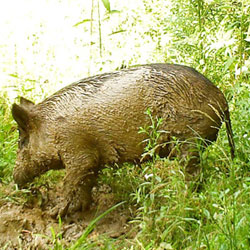 Wild hogs—also called wild pigs, wild boar, or feral swine—are an invasive species in Indiana. Wild hogs have either been illegally released or were formerly domesticated pigs allowed to become feral (see 312 IAC 9-3-18.6 for full definition). These animals pose significant threats to both agricultural and ecological health.
Wild hogs—also called wild pigs, wild boar, or feral swine—are an invasive species in Indiana. Wild hogs have either been illegally released or were formerly domesticated pigs allowed to become feral (see 312 IAC 9-3-18.6 for full definition). These animals pose significant threats to both agricultural and ecological health.
General Characteristics
Although wild hogs look similar to domestic pigs, they have different characteristics:
- Their hair is coarse with long bristles.
- Their coat colors can be any combination of white, black, brown, and red. Piglets may have striped or spotted coats, but they will lose this pattern as the mature.
- Males (boars) are larger than females (sows).
- They weigh between 75-250 pounds on average.
- They can reach 3 feet in height and be up to 5 feet long.
To identify wild hogs in your area, look for specific signs of damage around you:
- Shallow disturbance to ground cover and the top layer of soil from rooting or digging, which generally occurs as wild hogs search for food (photo one).
- Wallows (or wet muddy pits) which hogs use to coat themselves in mud and serve as loafing areas to stay cool during warmer months (photo two).
- Tree rubs, which are areas on trees coated in mud that may be missing the bark layer, created by hogs rubbing on trees (photo 3).
- Tunnels and worn trails leading through thick vegetation.
- Hoof tracks in the mud near springs, ponds, and streams.
- Scat, which may resemble dog feces and may contain partially digested remnants of acorns, grains, and the hair, scales, or feathers of animals that have been eaten.
Typical wild hog damage
Photos courtesy of USDA-APHIS Wildlife Services.
Distribution and Abundance
There is no established population of wild hogs in Indiana. The home territory of a wild hog is around 10 square miles.
Food Habits
Wild hogs are opportunistic feeders. They prefer mast crops (acorns, hickory nuts, and beech nuts) in the fall. Other food items include grasses, roots, berries, fruits, insects, crops, crayfish, frogs, salamanders, snakes, mice, eggs of ground-nesting birds, young rabbits, fawns, and young livestock, such as lambs and goats.
Management and Control
A landowner, tenant, or other person with written permission from the landowner can shoot or trap a wild hog on that landowner’s private property without a permit. Be sure to check local ordinances before using a firearm. If trapped, the hog must be killed at the trap site or euthanized immediately. However, wild hogs cannot be offered for compensation of any kind for hunting or taking purposes and cannot be released into the wild. A person cannot charge a service fee for shooting, trapping, or removing a wild hog from private property unless the person has a nuisance wild animal control permit from the Division of Fish & Wildlife.
The DNR, in cooperation with the USDA-APHIS Wildlife Services and the Indiana State Board of Animal Health (BOAH), are working with impacted landowners in providing technical information to control wild hog populations. The DNR, BOAH and USDA-APHIS Wildlife Services do not provide information on where to hunt wild hogs in Indiana as part of this cooperative work with landowners.
Wild hogs cannot be imported into Indiana, possessed in captivity, sold, traded, bartered, leased, or gifted.
Negative Impacts of Wild Hogs on Natural Resources
Wild hog activity along streams and rivers can muddy the water, covering fish spawning beds in silt and decreasing oxygen levels in the water. Because hog diets overlap with those of wild turkey, squirrel, and deer, their presence decreases these species’ food availability. Hog activity may drive native wildlife from an area. Hogs also prey on the nests, eggs, and young of native birds and reptiles, some of which are threatened and endangered. Along with this predatory behavior, wild hogs also damage wildlife nesting and winter cover for other species.
The rooting, digging, and wallowing activities of wild hogs increases the possibility of erosion, especially in wetlands and along streams and rivers. On farmland, wild hogs can cause extensive damage to crops. Large groups of wild hogs can also contaminate water sources through these activities, along with their fecal material, which can increase the risk of disease in wildlife, livestock, and humans.
If I see wild hogs, what should I do?
Individuals observing wild hogs are asked to contact one of the following to report the approximate location and number of hogs observed:
- Indiana USDA-WS at 855-386-0370
- Indiana Division of Fish & Wildlife at dfw@dnr.IN.gov
Individuals observing the illegal possession, importation or release of wild hogs should contact DNR Law Enforcement at 1-800-TIP-IDNR.
